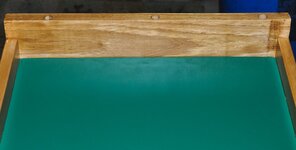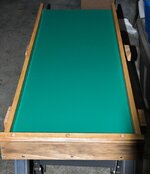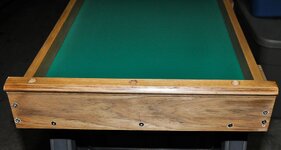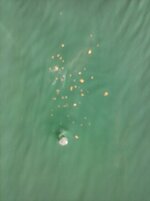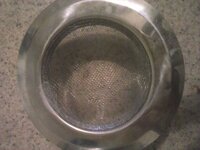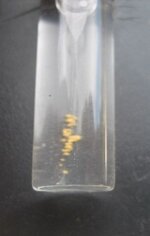DizzyDigger
Gold Member
- Dec 9, 2012
- 6,391
- 12,973
- Detector(s) used
- Nokta FoRs Gold, a Gold Cube, 2 Keene Sluices and Lord only knows how many pans....not to mention a load of other gear my wife still doesn't know about!
- Primary Interest:
- Prospecting
Made a diligent search for a suitable piece of slate or other appropriate stone material
(ie: affordable), but have decided instead to build using a solid wood top and numerous
coats of chalkboard paint.
Poking around my shop I came up with this old table leaf I'd shoved in the back of
my wood stack some years ago. We gave the table away to a young couple, but they
didn't take the extra leaf as there wasn't room in their dining area for the table to be
any larger than it was.
I checked it using a 5' level, and the surface is perfectly flat from end to end and
side to side.
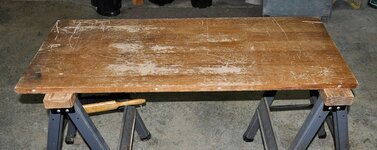
Looks to be solid maple, with a thin layer of hardwood laminate covering the
top. I've since cut it to 16" wide, as there's an area notched along one edge that needed
to be removed, and a 16" width will work just fine. Next step is to sand all that old
stain off, and prepare it for a coat of sealer. (which I'm about done with as I write).
Finished table will be 15-7/8" wide by 43" long.
For a sealer coat I have a full can of Helmsman Spar Urethane, and plan to apply
several coats (to all sides/edges), with sanding between coats to insure a smooth surface.
Pics as it comes along, and as always, I'm completely open to helpful suggestions.
(Just don't get too far ahead of me.. )
)
(ie: affordable), but have decided instead to build using a solid wood top and numerous
coats of chalkboard paint.
Poking around my shop I came up with this old table leaf I'd shoved in the back of
my wood stack some years ago. We gave the table away to a young couple, but they
didn't take the extra leaf as there wasn't room in their dining area for the table to be
any larger than it was.
I checked it using a 5' level, and the surface is perfectly flat from end to end and
side to side.

Looks to be solid maple, with a thin layer of hardwood laminate covering the
top. I've since cut it to 16" wide, as there's an area notched along one edge that needed
to be removed, and a 16" width will work just fine. Next step is to sand all that old
stain off, and prepare it for a coat of sealer. (which I'm about done with as I write).
Finished table will be 15-7/8" wide by 43" long.
For a sealer coat I have a full can of Helmsman Spar Urethane, and plan to apply
several coats (to all sides/edges), with sanding between coats to insure a smooth surface.
Pics as it comes along, and as always, I'm completely open to helpful suggestions.
(Just don't get too far ahead of me..
 )
)
Last edited:
Upvote
0






 I'm just going to hang out and see how it goes. The gold we get here isn't that fine usually but we do get some and I've been curious as to what if anything I might find in my cons. I could see gold in the cons I saved from my first few times out but every time I would try to pan the gold would float. I then ran them through my gold hog matting and I got almost a gram of superfine powder and the only way I was able to recover was with some leftover "quicksilver" from another recovery. Once you guys get that superfine stuff out how do you manage to capture it into a vial?
I'm just going to hang out and see how it goes. The gold we get here isn't that fine usually but we do get some and I've been curious as to what if anything I might find in my cons. I could see gold in the cons I saved from my first few times out but every time I would try to pan the gold would float. I then ran them through my gold hog matting and I got almost a gram of superfine powder and the only way I was able to recover was with some leftover "quicksilver" from another recovery. Once you guys get that superfine stuff out how do you manage to capture it into a vial?

